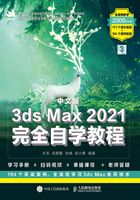
1.4 3ds Max 2021的常用工具
掌握主工具栏中常用工具的用法,可以为后续学习打下基础。这些工具包括撤销、对象选择、参考坐标系、捕捉、镜像和对齐,如图1-63所示。

图1-63
重点1.4.1 撤销

扫码观看视频
“撤销”工具 (快捷键为Ctrl+Z)用来撤销上一步执行的操作。连续单击“撤销”按钮
(快捷键为Ctrl+Z)用来撤销上一步执行的操作。连续单击“撤销”按钮 会持续撤销上一步执行的操作,默认的最大撤销步骤为20步。
会持续撤销上一步执行的操作,默认的最大撤销步骤为20步。
如果需要增加撤销的步数,执行“自定义>首选项”菜单命令,在打开的“首选项设置”对话框的“常规”选项卡中,设置“场景撤销”的“级别”为任意数值,如图1-64所示。
技巧提示:“级别”参数的作用
“级别”数值设置得越大,文件所占的内存就越多,读者在设置该数值时最好不要超过50。

图1-64
重点1.4.2 选择过滤器

扫码观看视频
“选择过滤器”工具 是用来过滤不需要选择的对象类型,这对于批量选择同一种类型的对象非常有用,如图1-65所示。
是用来过滤不需要选择的对象类型,这对于批量选择同一种类型的对象非常有用,如图1-65所示。
例如,在下拉列表中选择“L-灯光”选项,在场景中选择对象时只能选择灯光,而几何体、图形、摄影机等对象不会被选中,如图1-66所示。

图1-65

图1-66
重点1.4.3 选择对象

扫码观看视频
“选择对象”工具 (Q键)用于选择场景中的对象,在只想选择对象而又不想移动它的时候,选择该工具后单击对象即可选择相应的对象,如图1-67所示。
(Q键)用于选择场景中的对象,在只想选择对象而又不想移动它的时候,选择该工具后单击对象即可选择相应的对象,如图1-67所示。
选择对象的方法除了单独选择外,还可以加选、减选、反选和孤立选择。
加选对象 如果当前选择了一个对象,还想加选其他对象,可以在按住Ctrl键的同时单击其他对象,如图1-68所示。
减选对象 如果当前选择了多个对象,想减去某个不想选择的对象,可以在按住Alt键的同时单击想要减去的对象,如图1-69所示。

图1-67

图1-68

图1-69
反选对象 如果当前选择了某些对象,想要反选其他没被选择的对象,可以按Ctrl+I快捷键完成选择,如图1-70所示。
孤立选择对象 这是一种特殊的选择对象的方法,可以将选择的对象单独显示出来,以方便对其进行编辑,如图1-71所示。切换孤立选择对象的方法主要有两种,一种是执行“工具>孤立当前选择”菜单命令或直接按Alt+Q快捷键;另一种是在视图中单击鼠标右键,然后在弹出的快捷菜单中选择“孤立当前选择”选项。

图1-70

图1-71
重点1.4.4 选择并移动

扫码观看视频
“选择并移动”工具 (W键)用于移动对象的位置。当使用该工具选择对象时,视图中会显示坐标移动控制器。在默认的四视图中,只有透视视图显示的是x轴、y轴和z轴这3个轴向,而其他3个视图只显示其中的某两个轴向,如图1-72所示。如果想移动对象,可以将光标放在某个轴向上,然后按住鼠标左键进行拖曳,如图1-73所示。
(W键)用于移动对象的位置。当使用该工具选择对象时,视图中会显示坐标移动控制器。在默认的四视图中,只有透视视图显示的是x轴、y轴和z轴这3个轴向,而其他3个视图只显示其中的某两个轴向,如图1-72所示。如果想移动对象,可以将光标放在某个轴向上,然后按住鼠标左键进行拖曳,如图1-73所示。

图1-72

图1-73
技巧提示:放大、缩小坐标控制器的快捷方法
按键盘上的“+”键或“-”键,可以放大或缩小坐标控制器。
重点案例训练:用选择并移动工具摆放几何体

扫码观看视频
场景文件 场景文件>CH01>01.max
实例文件 无
难易程度 ★☆☆☆☆
技术掌握 练习选择并移动工具
本案例是将散落的几何体模型用“选择并移动”工具 进行拼合,案例对比效果如图1-74所示。
进行拼合,案例对比效果如图1-74所示。
 打开本书学习资源中的“场景文件>CH01>01.max”文件。如图1-75所示,场景中散落着几何体模型,需要将其拼合为一个整体。
打开本书学习资源中的“场景文件>CH01>01.max”文件。如图1-75所示,场景中散落着几何体模型,需要将其拼合为一个整体。
 在“主工具栏”上单击“选择并移动”按钮
在“主工具栏”上单击“选择并移动”按钮 ,然后选中场景中的紫色立方体,此时紫色立方体会出现坐标轴,如图1-76所示。
,然后选中场景中的紫色立方体,此时紫色立方体会出现坐标轴,如图1-76所示。

图1-74

图1-75

图1-76
技巧提示:取消线框的方法
选中紫色立方体后,紫色立方体的边缘会显示白色的线框。如果读者觉得该线框影响观察,按J键即可取消线框,如图1-77所示。

图1-77
 将光标移动到坐标轴的x轴上,此时光标会显示为黄色,然后按住鼠标左键向左拖曳,将紫色立方体与蓝色立方体拼合,如图1-78所示。
将光标移动到坐标轴的x轴上,此时光标会显示为黄色,然后按住鼠标左键向左拖曳,将紫色立方体与蓝色立方体拼合,如图1-78所示。
 在透视视图中很难准确将紫色立方体与蓝色立方体完全拼合,这时就需要切换到四视图模式。在四视图模式中,我们可以观察顶视图和左视图,然后在x轴和y轴上移动紫色立方体,从而将两个立方体完全拼合,如图1-79所示。
在透视视图中很难准确将紫色立方体与蓝色立方体完全拼合,这时就需要切换到四视图模式。在四视图模式中,我们可以观察顶视图和左视图,然后在x轴和y轴上移动紫色立方体,从而将两个立方体完全拼合,如图1-79所示。

图1-78

图1-79
知识链接:捕捉开关
如果要让两个立方体严丝合缝地拼合,就需要用到1.4.9中讲到的“捕捉开关”工具。
 选中青色立方体,然后沿着y轴和z轴将其移动到紫色立方体的上方,如图1-80所示。在顶视图中,先将青色立方体与紫色立方体重合,然后在前视图中,将青色立方体移动到紫色立方体上方。
选中青色立方体,然后沿着y轴和z轴将其移动到紫色立方体的上方,如图1-80所示。在顶视图中,先将青色立方体与紫色立方体重合,然后在前视图中,将青色立方体移动到紫色立方体上方。
 选中剩下的绿色立方体,然后将其移动到青色立方体的右侧,如图1-81所示。
选中剩下的绿色立方体,然后将其移动到青色立方体的右侧,如图1-81所示。
 最大化显示透视视图,然后在空白场景处单击,取消对象选择,接着按Z键将视图中的模型居中最大化显示,如图1-82所示。至此,本案例制作完成。
最大化显示透视视图,然后在空白场景处单击,取消对象选择,接着按Z键将视图中的模型居中最大化显示,如图1-82所示。至此,本案例制作完成。

图1-80

图1-81

图1-82
重点1.4.5 选择并旋转

扫码观看视频
“选择并旋转”工具 (E键)用于选择并旋转对象,其使用方法与“选择并移动”工具
(E键)用于选择并旋转对象,其使用方法与“选择并移动”工具 相似。当该工具处于激活状态(选择状态)时,被选中的对象可以在x轴、y轴和z轴这3个轴上进行旋转,如图1-83所示。
相似。当该工具处于激活状态(选择状态)时,被选中的对象可以在x轴、y轴和z轴这3个轴上进行旋转,如图1-83所示。

图1-83
重点案例训练:用选择并旋转工具摆放苹果

扫码观看视频
场景文件 场景文件>CH01>02.max
实例文件 无
难易程度 ★☆☆☆☆
技术掌握 练习选择并旋转工具
本案例是将倾倒的苹果模型摆正,案例对比效果如图1-84所示。
 打开本书学习资源中的“场景文件>CH01>02.max”文件,如图1-85所示。
打开本书学习资源中的“场景文件>CH01>02.max”文件,如图1-85所示。
 图1-85中右侧的苹果模型呈倾倒效果,需要将其摆正,使其效果和左侧的苹果模型一样。在“主工具栏”上单击“选择并旋转”按钮
图1-85中右侧的苹果模型呈倾倒效果,需要将其摆正,使其效果和左侧的苹果模型一样。在“主工具栏”上单击“选择并旋转”按钮 ,然后选中倾倒的苹果模型,此时倾倒的苹果模型上方会显示圆形的坐标轴,如图1-86所示。
,然后选中倾倒的苹果模型,此时倾倒的苹果模型上方会显示圆形的坐标轴,如图1-86所示。

图1-84

图1-85

图1-86
 将光标放在y轴上,然后向左拖曳鼠标,使倾倒的苹果模型向左旋转,如图1-87所示。
将光标放在y轴上,然后向左拖曳鼠标,使倾倒的苹果模型向左旋转,如图1-87所示。

图1-87

图1-88
技巧提示:旋转苹果模型时避免模型分离
在选择苹果模型时,一定要将苹果模型与苹果把模型一同选中,否则旋转时会出现问题。
 继续沿着x轴旋转,在透视视图中观察苹果模型呈现摆正效果,如图1-88所示。
继续沿着x轴旋转,在透视视图中观察苹果模型呈现摆正效果,如图1-88所示。
 切换到四视图模式,苹果模型在前视图和左视图中仍然有倾斜,如图1-89所示。
切换到四视图模式,苹果模型在前视图和左视图中仍然有倾斜,如图1-89所示。
 在前视图和左视图中调整苹果模型的角度,使其摆正,如图1-90所示。
在前视图和左视图中调整苹果模型的角度,使其摆正,如图1-90所示。

图1-89

图1-90
技巧提示:在四视图模式下检查
在透视视图中,右侧的苹果模型会因为视觉误差而呈摆正状态,我们需要在四视图模式下检查。
 使用“选择并移动”工具
使用“选择并移动”工具 ,将右侧的苹果模型移动到左侧的苹果模型旁边,案例最终效果如图1-91所示。
,将右侧的苹果模型移动到左侧的苹果模型旁边,案例最终效果如图1-91所示。

图1-91
重点1.4.6 选择并均匀缩放

扫码观看视频
“选择并均匀缩放”工具 (R键)用于选择并均匀缩放对象,还包含“选择并非均匀缩放”工具
(R键)用于选择并均匀缩放对象,还包含“选择并非均匀缩放”工具 和“选择并挤压”工具
和“选择并挤压”工具 ,如图1-92所示。
,如图1-92所示。

图1-92
使用“选择并均匀缩放”工具 可以沿3个轴以相同量缩放对象,同时保持对象的原始比例,如图1-93所示。
可以沿3个轴以相同量缩放对象,同时保持对象的原始比例,如图1-93所示。
使用“选择并非均匀缩放”工具 可以根据活动轴约束以非均匀方式缩放对象,如图1-94所示。
可以根据活动轴约束以非均匀方式缩放对象,如图1-94所示。
使用“选择并挤压”工具 可以创建挤压和拉伸效果,如图1-95所示。
可以创建挤压和拉伸效果,如图1-95所示。

图1-93

图1-94

图1-95
重点案例训练:用选择并缩放工具变形球类器材

扫码观看视频
场景文件 场景文件>CH01>03.max
实例文件 无
难易程度 ★☆☆☆☆
技术掌握 练习选择并均匀缩放工具
本案例用3种缩放工具使球类器材模型变形,案例对比效果如图1-96所示。

图1-96
 打开本书学习资源中的“场景文件>CH01>03.max”文件,如图1-97所示。
打开本书学习资源中的“场景文件>CH01>03.max”文件,如图1-97所示。
 使用“选择并均匀缩放”工具
使用“选择并均匀缩放”工具 选中篮球模型,然后拖曳鼠标将其均匀缩小,效果如图1-98所示。
选中篮球模型,然后拖曳鼠标将其均匀缩小,效果如图1-98所示。
 使用“选择并非均匀缩放”工具
使用“选择并非均匀缩放”工具 选中足球模型,然后沿着xy平面拖曳鼠标将其缩小,效果如图1-99所示。
选中足球模型,然后沿着xy平面拖曳鼠标将其缩小,效果如图1-99所示。
 使用“选择并挤压”工具
使用“选择并挤压”工具 选中排球模型,然后沿着xy平面拖曳鼠标将其压扁,效果如图1-100所示。
选中排球模型,然后沿着xy平面拖曳鼠标将其压扁,效果如图1-100所示。

图1-97

图1-98

图1-99

图1-100
重点1.4.7 参考坐标系

扫码观看视频
“参考坐标系”工具 是用来指定变换操作(如移动、旋转、缩放等)的坐标系统,包括“视图”“屏幕”“世界”“父对象”“局部”“万向”“栅格”“工作”“局部对齐”“拾取”10种坐标系,如图1-101所示。
是用来指定变换操作(如移动、旋转、缩放等)的坐标系统,包括“视图”“屏幕”“世界”“父对象”“局部”“万向”“栅格”“工作”“局部对齐”“拾取”10种坐标系,如图1-101所示。

图1-101
每种坐标系会按照不同的标准呈现坐标轴的方向。“视图”坐标系是系统默认的坐标系,不同的视图有不同的坐标,如图1-102所示。
“世界”坐标系在每个视图的坐标显示方式,都与视图左下角的世界坐标相吻合,如图1-103所示。
“局部”坐标系会根据对象的法线显示坐标位置,如图1-104所示。至于其他的坐标系类型,在日常工作中运用不多,这里不讲述。

图1-102

图1-103

图1-104
重点1.4.8 使用轴点中心

扫码观看视频
“使用轴点中心”工具 包含3种工具,如图1-105所示。
包含3种工具,如图1-105所示。
“使用轴点中心”工具 是围绕其各自的轴点旋转或缩放一个或多个对象,如图1-106所示。
是围绕其各自的轴点旋转或缩放一个或多个对象,如图1-106所示。
“使用选择中心”工具 是围绕其共同的几何中心旋转或缩放一个或多个对象(如果变换多个对象,该工具会计算所有对象的平均几何中心,并将该几何中心作为变换中心),如图1-107所示。
是围绕其共同的几何中心旋转或缩放一个或多个对象(如果变换多个对象,该工具会计算所有对象的平均几何中心,并将该几何中心作为变换中心),如图1-107所示。

图1-105
技巧提示:轴点位置
当对象的轴点中心和几何中心重叠时,两个轴心位置一致。
“使用变换坐标中心”工具 是围绕当前坐标系的中心旋转或缩放一个或多个对象(当使用“拾取”功能将其他对象指定为坐标系时,其坐标中心在该对象的轴的位置上),如图1-108所示。
是围绕当前坐标系的中心旋转或缩放一个或多个对象(当使用“拾取”功能将其他对象指定为坐标系时,其坐标中心在该对象的轴的位置上),如图1-108所示。

图1-106

图1-107

图1-108
重点1.4.9 捕捉开关

扫码观看视频
“捕捉开关”工具 可以将对象精确拼合。“捕捉开关”工具包含3种类型,分别是“2D捕捉”“2.5D捕捉”“3D捕捉”,如图1-109所示。
可以将对象精确拼合。“捕捉开关”工具包含3种类型,分别是“2D捕捉”“2.5D捕捉”“3D捕捉”,如图1-109所示。

图1-109
“2D捕捉”工具 是在二维视图中进行捕捉,如图1-110所示。
是在二维视图中进行捕捉,如图1-110所示。
“2.5D捕捉”工具 主要用于捕捉结构或捕捉根据网格得到的几何体,也是常用的捕捉工具,如图1-111所示。
主要用于捕捉结构或捕捉根据网格得到的几何体,也是常用的捕捉工具,如图1-111所示。

图1-110

图1-111
“3D捕捉”工具 可以捕捉3D空间中的任何位置,如图1-112所示。
可以捕捉3D空间中的任何位置,如图1-112所示。

图1-112
技巧提示:捕捉点的设置方法
在“捕捉开关”工具 上单击鼠标右键,打开“栅格和捕捉设置”面板,在该对话框中可以设置捕捉类型和捕捉的相关选项,如图1-113所示。
上单击鼠标右键,打开“栅格和捕捉设置”面板,在该对话框中可以设置捕捉类型和捕捉的相关选项,如图1-113所示。

图1-113
重点案例训练:用捕捉开关工具拼合桌子

扫码观看视频
场景文件 场景文件>CH01>04.max
实例文件 无
难易程度 ★☆☆☆☆
技术掌握 练习捕捉开关工具
本案例是用“捕捉开关”工具 拼合桌子模型,案例对比效果如图1-114所示。
拼合桌子模型,案例对比效果如图1-114所示。

图1-114
 打开本书学习资源中的“场景文件>CH01>04.max”文件,如图1-115所示。这是桌子模型的分拆效果,我们需要将其拼合为一个整体。
打开本书学习资源中的“场景文件>CH01>04.max”文件,如图1-115所示。这是桌子模型的分拆效果,我们需要将其拼合为一个整体。
 在“2.5D捕捉”工具
在“2.5D捕捉”工具 上单击鼠标右键,在打开的“栅格和捕捉设置”面板中勾选“顶点”选项,如图1-116所示。
上单击鼠标右键,在打开的“栅格和捕捉设置”面板中勾选“顶点”选项,如图1-116所示。
 切换到顶视图,然后使用“选择并移动”工具
切换到顶视图,然后使用“选择并移动”工具 选中一个桌腿模型,接着将其移动到桌面模型的边角处,两个模型在相遇时会有自动吸附的效果,如图1-117所示。
选中一个桌腿模型,接着将其移动到桌面模型的边角处,两个模型在相遇时会有自动吸附的效果,如图1-117所示。
 按照上一步的方法,将其他3个桌腿模型也移动到桌面模型对应的边角处,如图1-118所示。
按照上一步的方法,将其他3个桌腿模型也移动到桌面模型对应的边角处,如图1-118所示。

图1-115

图1-116

图1-117

图1-118
 切换到前视图,可以发现桌面模型处于桌腿模型的中间位置,如图1-119所示。同样使用“选择并移动”工具
切换到前视图,可以发现桌面模型处于桌腿模型的中间位置,如图1-119所示。同样使用“选择并移动”工具 将桌面模型与桌腿模型的顶部对齐,如图1-120所示。
将桌面模型与桌腿模型的顶部对齐,如图1-120所示。
 切换到透视视图,拼合完成的桌子模型如图1-121所示。
切换到透视视图,拼合完成的桌子模型如图1-121所示。

图1-119

图1-120

图1-121
重点1.4.10 角度捕捉切换

扫码观看视频
“角度捕捉切换”工具 (A键)用于指定捕捉的角度。激活该工具后,所有的旋转变换都将受到影响,默认状态下,模型以5°为增量进行旋转,如图1-122所示。
(A键)用于指定捕捉的角度。激活该工具后,所有的旋转变换都将受到影响,默认状态下,模型以5°为增量进行旋转,如图1-122所示。

图1-122
技巧提示:角度捕捉的设置方法
若要更改旋转增量,可以在“角度捕捉切换”工具 上单击鼠标右键,然后在弹出的“栅格和捕捉设置”面板的“选项”选项卡中,设置“角度”数值以控制旋转的角度,如图1-123所示。
上单击鼠标右键,然后在弹出的“栅格和捕捉设置”面板的“选项”选项卡中,设置“角度”数值以控制旋转的角度,如图1-123所示。

图1-123
重点案例训练:用角度捕捉切换工具拼合花瓣模型

扫码观看视频
场景文件 场景文件>CH01>05.max
实例文件 无
难易程度 ★☆☆☆☆
技术掌握 练习角度捕捉切换工具
本案例是用“角度捕捉切换”工具 拼合花瓣模型,案例对比效果如图1-124所示。
拼合花瓣模型,案例对比效果如图1-124所示。
 打开本书学习资源中的“场景文件>CH01>05.max”文件,如图1-125所示。
打开本书学习资源中的“场景文件>CH01>05.max”文件,如图1-125所示。
 使用“选择并旋转”工具
使用“选择并旋转”工具 选中花瓣模型,可以观察到旋转坐标(即模型的坐标中心)位于花心模型的中央,如图1-126所示。
选中花瓣模型,可以观察到旋转坐标(即模型的坐标中心)位于花心模型的中央,如图1-126所示。

图1-124

图1-125

图1-126
知识课堂:调整模型的坐标中心位置
模型的默认坐标中心位置都位于模型的中心。如果要调整模型的坐标中心,就需要切换到 “层次”面板,然后单击“仅影响轴”按钮 ,接着使用“选择并移动”工具
,接着使用“选择并移动”工具 就可以移动模型的坐标中心位置,如图1-127所示。
就可以移动模型的坐标中心位置,如图1-127所示。
当单击“仅影响轴”按钮 后,“选择并移动”工具
后,“选择并移动”工具 的坐标轴就会变为图1-128所示的效果,这就代表此时移动的是坐标轴,而不是模型本身。
的坐标轴就会变为图1-128所示的效果,这就代表此时移动的是坐标轴,而不是模型本身。
移动完坐标轴后,一定要再次单击“仅影响轴”按钮 ,这样就可以退出坐标轴的编辑状态,以便进行对模型的操作。
,这样就可以退出坐标轴的编辑状态,以便进行对模型的操作。

图1-127

图1-128
 单击“角度捕捉切换”按钮
单击“角度捕捉切换”按钮 ,按住Shift键,然后将花瓣模型沿着z轴旋转70°,如图1-129所示。
,按住Shift键,然后将花瓣模型沿着z轴旋转70°,如图1-129所示。
 此时系统会弹出“克隆选项”对话框,这里直接单击“确定”按钮
此时系统会弹出“克隆选项”对话框,这里直接单击“确定”按钮 即可,如图1-130所示。
即可,如图1-130所示。
 按照上面的方法,继续复制3个花瓣模型,案例效果如图1-131所示。
按照上面的方法,继续复制3个花瓣模型,案例效果如图1-131所示。
知识链接:克隆选项
关于“克隆选项”对话框的具体用法,请参阅“1.6.1 复制对象”的相关内容。

图1-129

图1-130

图1-131
重点1.4.11 镜像

扫码观看视频
“镜像”工具 可以围绕一个轴心镜像出一个或多个副本对象。选中镜像的对象后,然后单击“镜像”工具
可以围绕一个轴心镜像出一个或多个副本对象。选中镜像的对象后,然后单击“镜像”工具 ,打开“镜像:世界坐标”对话框,在该对话框中对“镜像轴”“克隆当前选择”“镜像IK限制”进行设置,如图1-132所示。
,打开“镜像:世界坐标”对话框,在该对话框中对“镜像轴”“克隆当前选择”“镜像IK限制”进行设置,如图1-132所示。
在“镜像:世界坐标”对话框中,我们首先要设置的参数就是“镜像轴”,只有确定了镜像轴的方向,才能继续下面的操作。图1-133所示是将一个圆凳模型以x轴镜像后的效果。
设置“镜像轴”后,对象会按照镜像轴的方向转变,原有的对象并不会保留。如果既要保留原有的对象,又要生成镜像对象,就需要在“克隆当前选择”选项组中选择“复制”或“实例”选项,如图1-134所示。

图1-132

图1-133

图1-134
重点案例训练:用镜像工具摆放椅子模型

扫码观看视频
场景文件 场景文件>CH01>06.max
实例文件 无
难易程度 ★☆☆☆☆
技术掌握 练习镜像工具
本案例是用“镜像”工具 摆放椅子模型,案例对比效果如图1-135所示。
摆放椅子模型,案例对比效果如图1-135所示。

图1-135
 打开本书学习资源中的“场景文件>CH01>06.max”文件,如图1-136所示。
打开本书学习资源中的“场景文件>CH01>06.max”文件,如图1-136所示。
 选中椅子模型,然后在主工具栏中单击“镜像”按钮
选中椅子模型,然后在主工具栏中单击“镜像”按钮 ,在弹出的“镜像:屏幕坐标”对话框中设置“镜像轴”为X,“偏移”为2600mm,“克隆当前选择”为“复制”,并单击“确定”按钮
,在弹出的“镜像:屏幕坐标”对话框中设置“镜像轴”为X,“偏移”为2600mm,“克隆当前选择”为“复制”,并单击“确定”按钮 ,如图1-137所示。镜像出的椅子模型效果如图1-138所示。我们可以观察到镜像出的椅子模型出现在桌子的另一侧。
,如图1-137所示。镜像出的椅子模型效果如图1-138所示。我们可以观察到镜像出的椅子模型出现在桌子的另一侧。
技巧提示:镜像移动的另一种方法
读者若是觉得“偏移”数值不方便设置,可以先镜像复制椅子模型,然后使用“选择并移动”工具 进行移动。
进行移动。

图1-136

图1-137

图1-138
 选中镜像出的椅子模型,然后单击“镜像”按钮
选中镜像出的椅子模型,然后单击“镜像”按钮 ,在弹出的对话框中设置“镜像轴”为X,“偏移”为-700mm,“克隆当前选择”为“复制”,如图1-139所示。镜像出的椅子模型效果如图1-140所示。
,在弹出的对话框中设置“镜像轴”为X,“偏移”为-700mm,“克隆当前选择”为“复制”,如图1-139所示。镜像出的椅子模型效果如图1-140所示。
 将椅子模型顺时针旋转90°,然后将其移动到桌子边缘,效果如图1-141所示。
将椅子模型顺时针旋转90°,然后将其移动到桌子边缘,效果如图1-141所示。

图1-139

图1-140

图1-141
 选中旋转后的椅子模型,然后单击“镜像”按钮
选中旋转后的椅子模型,然后单击“镜像”按钮 ,在弹出的对话框中设置“镜像轴”为X,“偏移”为-500mm,“克隆当前选择”为“复制”,如图1-142所示。镜像出的椅子模型效果如图1-143所示。
,在弹出的对话框中设置“镜像轴”为X,“偏移”为-500mm,“克隆当前选择”为“复制”,如图1-142所示。镜像出的椅子模型效果如图1-143所示。
 按照上一步的方法继续向左镜像复制一个椅子模型,如图1-144所示。
按照上一步的方法继续向左镜像复制一个椅子模型,如图1-144所示。

图1-142

图1-143

图1-144
 选中图1-145所示的椅子模型,然后单击“镜像”按钮
选中图1-145所示的椅子模型,然后单击“镜像”按钮 ,在弹出的对话框中设置“镜像轴”为Y,“偏移”为-1100mm,“克隆当前选择”为“复制”,如图1-146所示。
,在弹出的对话框中设置“镜像轴”为Y,“偏移”为-1100mm,“克隆当前选择”为“复制”,如图1-146所示。
 单击“确定”按钮
单击“确定”按钮 后,镜像复制的椅子模型会出现在桌子的另一端,如图1-147所示。至此,本案例制作完成。
后,镜像复制的椅子模型会出现在桌子的另一端,如图1-147所示。至此,本案例制作完成。

图1-145

图1-146

图1-147
重点1.4.12 对齐

扫码观看视频
“对齐”包括6种工具,分别是“对齐”工具 (快捷键为Alt+A)、“快速对齐”工具
(快捷键为Alt+A)、“快速对齐”工具 (快捷键为Shift+A)、“法线对齐”工具
(快捷键为Shift+A)、“法线对齐”工具 (快捷键为Alt+N)、“放置高光”工具
(快捷键为Alt+N)、“放置高光”工具 (快捷键为Ctrl+H)、“对齐摄影机”工具
(快捷键为Ctrl+H)、“对齐摄影机”工具 和“对齐到视图”工具
和“对齐到视图”工具 ,如图1-148所示。
,如图1-148所示。
选中场景中的任意一个对象,然后单击“对齐”按钮 ,接着选中场景中需要对齐的对象,就会弹出“对齐当前选择”对话框,如图1-149所示。
,接着选中场景中需要对齐的对象,就会弹出“对齐当前选择”对话框,如图1-149所示。
图1-150所示是圆柱体模型与长方体模型轴点对齐的设置方法。此时圆柱体模型以长方体模型为目标对象,进行轴点对齐,圆柱体模型放置在长方体模型轴点中心的正下方。

图1-148

图1-149

图1-150
重点案例训练:用对齐工具摆放积木

扫码观看视频
场景文件 场景文件>CH01>07.max
实例文件 无
难易程度 ★☆☆☆☆
技术掌握 练习对齐工具
本案例是用“对齐”工具 摆放几何体模型,案例对比效果如图1-151所示。
摆放几何体模型,案例对比效果如图1-151所示。
 打开本书学习资源中的“场景文件>CH01>07.max”文件,如图1-152所示。场景中有几个几何体模型,需要用“对齐”工具
打开本书学习资源中的“场景文件>CH01>07.max”文件,如图1-152所示。场景中有几个几何体模型,需要用“对齐”工具 将其中心对齐。
将其中心对齐。

图1-151

图1-152
 选中圆柱体模型,然后在主工具栏上单击“对齐”按钮
选中圆柱体模型,然后在主工具栏上单击“对齐”按钮 ,接着在视图中选中立方体模型,此时系统会弹出“对齐当前选择”对话框,勾选“X位置”和“Y位置”选项,设置“当前对象”为“中心”,“目标对象”为“中心”,并单击“应用”按钮
,接着在视图中选中立方体模型,此时系统会弹出“对齐当前选择”对话框,勾选“X位置”和“Y位置”选项,设置“当前对象”为“中心”,“目标对象”为“中心”,并单击“应用”按钮 ,如图1-153所示。圆柱体模型和立方体模型会呈现中心对齐效果,如图1-154所示。
,如图1-153所示。圆柱体模型和立方体模型会呈现中心对齐效果,如图1-154所示。
单击“应用”按钮 后,模型会按照设置的参数自动对齐,但“对齐当前选择”对话框不会关闭,可以进行下一步的对齐操作。单击“确定”按钮
后,模型会按照设置的参数自动对齐,但“对齐当前选择”对话框不会关闭,可以进行下一步的对齐操作。单击“确定”按钮 后,模型会按照设置的参数自动对齐,但“对齐当前选择”对话框会关闭。
后,模型会按照设置的参数自动对齐,但“对齐当前选择”对话框会关闭。
技巧提示:“应用”按钮与“确定”按钮的区别

图1-153

图1-154
 继续在“对齐当前选择”对话框中勾选“Z位置”选项,设置“当前对象”为“最小”,“目标对象”为“最大”,如图1-155所示。单击“确定”按钮
继续在“对齐当前选择”对话框中勾选“Z位置”选项,设置“当前对象”为“最小”,“目标对象”为“最大”,如图1-155所示。单击“确定”按钮 后退出对话框,如图1-156所示。
后退出对话框,如图1-156所示。
 按照相同的方法将圆锥体模型对齐在圆柱体模型的顶部中心位置,效果如图1-157所示。
按照相同的方法将圆锥体模型对齐在圆柱体模型的顶部中心位置,效果如图1-157所示。
 向右侧镜像复制一个整体模型,案例最终效果如图1-158所示。
向右侧镜像复制一个整体模型,案例最终效果如图1-158所示。

图1-155

图1-156

图1-157

图1-158